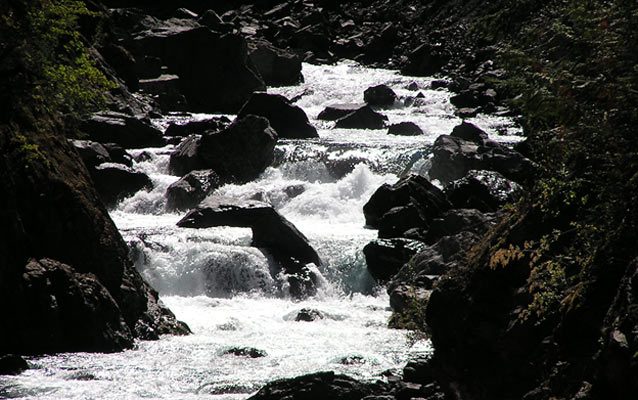Last updated: May 13, 2020
Lesson Plan
Freeing the Elwha (River Flows and Sediment Movement)

- Grade Level:
- Middle School: Sixth Grade through Eighth Grade
- Subject:
- Science
- Lesson Duration:
- 60 Minutes
- State Standards:
- Washington State Standards:
Science EALR 4 ES2G, ES3D, EALR 4 PS1C
Reading EALR 1 Component 1.2
Social Studies EALR 5 Component 5.2
Writing EALR 2 Component 2.1 - Thinking Skills:
- Remembering: Recalling or recognizing information ideas, and principles. Understanding: Understand the main idea of material heard, viewed, or read. Interpret or summarize the ideas in own words. Applying: Apply an abstract idea in a concrete situation to solve a problem or relate it to a prior experience. Analyzing: Break down a concept or idea into parts and show the relationships among the parts.
Essential Question
What combination of factors both natural and man-made is necessary for healthy river restoration, and how does this enhance the sustainability of natural and human communities?
Objective
Seasonal weather patterns affect the flow patterns of water into the rivers (and watersheds) of western North America. What landform features can form when erosion is caused by fast–moving water from Spring and Fall rains, and snowpack melt runoff?
Background
The focus of this lesson is to learn about the seasonal flow patterns of rivers in Western North America, and the erosional effects of fast-moving water. Rivers in the west tend to experience high flows during the spring rains and snowpack melt off, low flows during the long summer drought, increased flows during the return of the fall rains, and slightly lower flows in winter when much of the precipitation is trapped as snow. However, strong storms can result in sudden spikes of water flows and flash flooding.
Fast-flowing rivers can move large stones and carry a lot of sediment, so they have the ability to pluck stones from the bedrock and can carve deep canyons. Eventually fast-flowing rivers form V-shaped valleys, with terraces/benches forming along former riverbeds. Where flows reach steep gradients, rapids and waterfalls will form. The goal of this lesson is to demonstrate the features that can form in these fast-flowing streams.
Time
One class period.
Preparation
- Lesson 3- River Flows and Sediment Movement Lesson Plan.doc
- River Flows and Sediment Movement Powerpoint
- Waterfalls and Headward Erosion Powerpoint
- River Flows and Sediment Movement Worksheets.doc
- Stream Table
Materials
Vocabulary Terms, Vocabulary Notes, Reflection Journal 1, Reflection Journal 2
Download River Flows and Sediment Movement Worksheets
Lesson 3: River Flows and Sediment Movement Lesson Plan
Download Lesson 3: River Flows and Sediment Movement Lesson Plan
Olympic River Flows and Sediment PowerPoint
Download Olympic River Flows and Sediment PowerPoint
Olympic Waterfalls and Erosion PowerPoint
Download Olympic Waterfalls and Erosion PowerPoint
Procedure
1. Review the Essential Question, introduce the Guiding Question.
2. Students should take a few minutes to respond to the First Reflection Journal page. Discuss their answers and any questions they've generated.
3. Hand out Vocabulary Notes. Review the words. Students can define words as they watch the PowerPoint Lessons.
4. Present the PowerPoint Lessons.
5. Run Demonstration on stream table of high gradient V-shaped valleys.
6. Run Demonstration on stream table of waterfalls and headward erosion.
7. Have students identify elements from the PowerPoint lessons and the vocabulary notes on the stream table.
8. Finally, have students respond to the Second Reflection Journal page.
Vocabulary
- V-shaped valley: A steep valley carved by a fast-flowing river that takes on a shape that resembles a V.
- Terrace/bench: A generally flat area elevated above a river, which at one time was the former riverbed, before the river eroded deeper into the basin.
- Rapids: A sudden change in gradient, particularly over erosion-resistant materials, will cause the river to become turbulent and the velocity increases.
- Waterfall: A cascade of falling water where there is a vertical or almost vertical step in a river.
- Kolk: A vortex in a fast-flowing river, which plucks river bed material, forming a depression in the rock and often a pool or pond.
- Plucking: The removal of stones from a riverbed or bedrock by the erosional force of moving water.
- Gorge: A deep, narrow section of a river caused by erosion into the bedrock.
Additional Resources
WASHINGTON STATE STANDARDS:
1.EALR 4: ES2G Landforms are created by processes that build up structures and processes that break down and carry away material through erosion and weathering.
-
Explain how a given landform (e.g., mountain) has been shaped by processes that build up structures (e.g., uplift) and by processes that break down and carry away material (e.g., weathering and erosion).
2. EALR 4: ES3D Earth has been shaped by many natural catastrophes, including earthquakes, volcanic eruptions, glaciers, floods, storms, tsunami, and the impacts of asteroids.
-
Interpret current landforms of the Pacific Northwest as evidence of past geologic events.
3. EALR 4: PS1C Unbalanced forces will cause changes in the speed or direction of an object’s motion.
- Determine whether forces on an object are balanced or unbalanced and justify with observational evidence.
Reading
1. EALR 1: The student understands and uses different skills and strategies to read.
- Component 1.2 Use vocabulary (word meaning) strategies to comprehend text.
Social Studies
1. EALR 5: The student understands and applies reasoning skills to conduct research, deliberate, form, and evaluate positions through the processes of reading, writing, and communicating.
- Component 5.2: Uses inquiry-based research.
Writing
1. EALR 2: The student writes in a variety of forms for different audiences and purposes.
- Component 2.1: Adapts writing for a variety of audiences.
